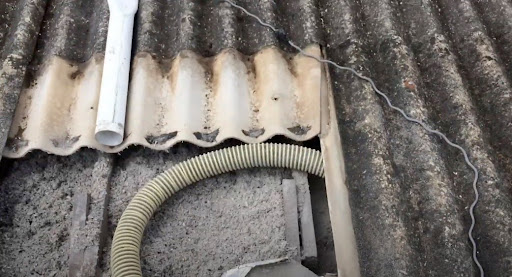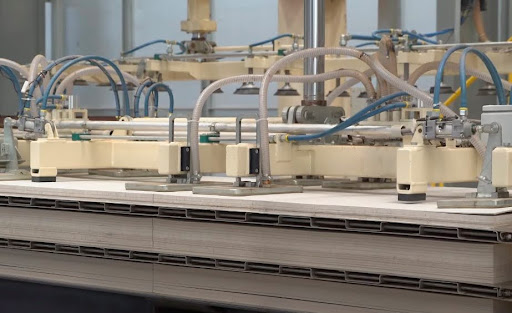For years, asbestos cladding has been a cause for concern in New Zealand. Formerly popular due to its fire resistance and long-lasting properties, this hazardous material was incorporated into construction materials like fibre cement claddings referred to as ‘fibrolites.’ Unfortunately, the serious health risks associated with it have resulted in stringent regulations on how best to handle and dispose of it safely. This guide takes an extensive look at asbestos cladding within NZ by focusing on identifying potential threats, proper testing techniques and safe removal practices.
What Does Asbestos Cladding Mean?

During the mid-20th century, asbestos cladding became a popular building material. It consists of cement mixed with fibers from asbestos to create a durable and sturdy surface suitable for constructing walls and roofs. New Zealand favored this type of cladding due to its affordability and impressive fire-resistant qualities.
Identifying Asbestos Cladding
An essential first measure is to identify asbestos cladding, given the high health dangers linked with exposure. The appearance of this type of cladding usually resembles flat sheets or planks reminiscent of ordinary cement ones. However, it can also show signs of deterioration like cracks and weather damage over time. Nevertheless, relying solely on visual cues may not be sufficient since this material’s looks are deceivingly similar to other substances. Expert testing from qualified professionals armed with required equipment offers the only dependable method for verifying its presence beyond doubt.
Key Characteristics of Asbestos Cladding
Understanding the fundamental features of asbestos cladding is crucial for ensuring precise identification, as they aid in distinguishing it from other construction materials.
- Appearance: The asbestos cladding can often be mistaken for ordinary cement sheets due to its flat sheet or plank-like appearance, without the usual fibrous look that is typically associated with asbestos.
- Color: Asbestos cladding is available in a variety of colors such as grey, off-white and beige. However, the color cannot serve as a distinct indication since it can resemble non-asbestos substances.
- Texture: The asbestos cladding commonly possesses a smooth and firm texture akin to cement-based materials. Nevertheless, relying solely on this characteristic for definitive recognition is inadequate.
- Size and Shape: Typically, asbestos cladding is produced in standard sheet or plank sizes that follow similar dimensions to those of traditional building materials. The specific measurements may differ but remain consistent overall.
- Age and Condition: The age and condition of asbestos cladding may result in visible indications such as cracking, weathering, or surface deterioration due to long-term exposure to the environment. Nonetheless, not all types of asbestos cladding will demonstrate these symptoms; therefore visual assessment is undependable.
Professional Testing for Asbestos Cladding
Professional testing is crucial for confirming the presence of asbestos in building materials due to its potential health risks. The following steps are involved in professional testing:
- Site Assessment: During the site assessment, a qualified individual with expertise in asbestos will inspect the premises and perform an exhaustive evaluation of all materials within the building that may potentially harbor asbestos.
- Sample Collection: TDuring the sample collection process, the specialist will diligently gather specimens of the questionable substance while adhering to rigorous safety measures in order to prevent any dispersion of asbestos fibers.
- Laboratory Analysis: The gathered samples are dispatched to a certified laboratory that specializes in analyzing asbestos. Skilled technicians will examine the specimens employing microscopy methodologies for detecting any traces of asbestos fibers.
- Reporting: After finishing the analysis, a comprehensive report is furnished by the laboratory that specifies whether asbestos exists and its variety and amount.
- Remediation or Management: Based on the findings, corresponding measures are implemented such as elimination of asbestos or enclosing it to avoid exposure and guarantee safety.
When to Test for Asbestos Cladding
Asbestos-containing materials (ACMs) were commonly used in construction before the 2000s due to their desirable properties like fire resistance and durability. However, exposure to asbestos fibers can pose serious health risks, including lung cancer and mesothelioma. To ensure safety and compliance with health and safety regulations in New Zealand, it is crucial to know when to test for asbestos cladding.
Renovation or Demolition
Before embarking on any renovation or demolition project involving buildings constructed before the 2000s, it is imperative to test for asbestos cladding. These older structures are more likely to contain asbestos-containing materials, including cladding. Renovation or demolition activities can disturb these materials, releasing asbestos fibers into the air if not handled properly. Thus, testing is crucial to identify the presence of asbestos and take necessary precautions.
Deterioration
Even if you are not planning a renovation or demolition, it’s essential to test for asbestos cladding if you notice any signs of damage or wear on the cladding. Asbestos-containing cladding may deteriorate over time, leading to the release of asbestos fibers into the environment. Common signs of deterioration include cracks, chips, or peeling of the cladding. Prompt testing and appropriate action are essential to mitigate health risks.
Health and Safety Compliance
To ensure your property complies with New Zealand’s health and safety regulations, asbestos testing is essential. Regulatory authorities mandate testing to protect the health and well-being of occupants and workers. Compliance not only helps prevent asbestos-related illnesses but also avoids legal repercussions. Regular testing, especially in older buildings, is a proactive step towards maintaining a safe and healthy environment.
How to Test Safely

Testing for asbestos cladding should always be conducted with safety as a top priority. Here’s how to do it safely:
- Professional Assessment: Engage a licensed asbestos assessor who has the expertise and certification to perform asbestos testing. These professionals are well-trained in identifying asbestos-containing materials and ensuring safe testing procedures.
- Sampling: The licensed asbestos assessor will take small samples of the cladding material in a manner that minimizes disturbance. This involves careful extraction techniques to prevent the release of asbestos fibers into the air. The samples are collected using appropriate tools and protective gear.
- Laboratory Testing: The samples collected are sent to an accredited laboratory for analysis. Accredited labs follow strict protocols for asbestos testing, ensuring accurate results. The laboratory will confirm whether asbestos is present in the samples and provide detailed information about the asbestos type and concentration.
Removing Asbestos Cladding
The removal of asbestos cladding should never be a DIY project. It involves several steps:
Hiring a Licensed Removalist
Asbestos removal is a highly specialized task that requires the expertise of licensed professionals who have undergone rigorous training and certification. Here are key points to consider when hiring a licensed removalist:
- Credentials: Verify that the removalist holds the necessary licenses and certifications to perform asbestos removal in compliance with NZ regulations.
- Experience: Choose a removalist with a proven track record in handling asbestos removal projects.
- Insurance: Ensure the removalist has adequate liability insurance to cover any unforeseen accidents or damages during the removal process.
- References: Request references from past clients to gauge the removalist’s reputation and reliability.
Creating a Removal Plan
Before commencing asbestos cladding removal, it is essential to develop a comprehensive removal plan that outlines the methods, timing, and safety measures. Here’s a breakdown of the removal plan:
- Methods: Detail the specific methods and techniques that will be used for asbestos removal, including encapsulation, enclosure, or full removal.
- Timing: Establish a clear timeline for the removal project, taking into account factors such as weather conditions and the availability of licensed professionals.
- Safety Measures: Prioritize safety by outlining the safety protocols and procedures to be followed throughout the removal process. Ensure that all workers are equipped with appropriate personal protective equipment (PPE).
Notifying Authorities
In NZ, it is mandatory to notify the relevant authorities before initiating asbestos removal. Failing to do so can result in legal consequences. Here’s what you need to know:
- Notification Process: Familiarize yourself with the specific process and forms required for notifying the authorities about your asbestos removal project.
- Timely Notification: Ensure that notification is submitted well in advance of the removal project’s commencement to allow for proper inspections and approvals.
Safety Precautions
Taking stringent safety precautions is crucial to preventing the release of asbestos fibers during removal. Key safety measures include:
- Personal Protective Equipment (PPE): All personnel involved in the removal must wear appropriate PPE, including respirators, disposable coveralls, gloves, and eye protection.
- Containment Methods: Employ effective containment methods, such as erecting plastic barriers and using negative air pressure systems, to prevent asbestos fibers from escaping into the environment.
- Air Monitoring: Conduct regular air monitoring to ensure that asbestos levels remain within safe limits throughout the removal process.
Disposal
Proper disposal of asbestos waste is essential to prevent contamination and health hazards. Follow these disposal guidelines:
- Designated Facilities: Asbestos waste must be transported and disposed of in approved and designated facilities equipped to handle hazardous materials.
- Packaging: Asbestos-containing materials should be securely double-bagged in thick plastic and labeled as hazardous waste.
- Transportation: Utilize licensed transporters who are experienced in handling asbestos waste and comply with regulations regarding its transportation.
Legal and Health Implications
Understanding the legal and health implications of asbestos removal is vital for compliance and safety:
- Legal Regulations: Familiarize yourself with NZ’s strict regulations governing asbestos removal, which are designed to protect both workers and the public.
- Health Risks: Be aware of the well-documented health risks associated with asbestos exposure, including asbestosis, lung cancer, and mesothelioma.
- Prohibition in New Construction: In NZ, the use of asbestos in new construction is banned, highlighting the government’s commitment to eliminating asbestos-related health hazards.
Maintaining Asbestos Cladding
If the asbestos cladding is in good condition and not disturbed, it might not pose an immediate risk. Regular checks and maintenance are crucial, including:
- Inspections: Conduct regular professional inspections.
- Record Keeping: Maintain a record of any assessments and work done on the cladding.
- Limit Disturbance: Avoid drilling, cutting, or doing anything that might release fibres.
Conclusion
Navigating the world of asbestos cladding in NZ requires knowledge, caution, and professional assistance. Whether you’re a homeowner, contractor, or property manager, understanding when and how to test for asbestos cladding is crucial. By following the right procedures and legal requirements, you can ensure safety and compliance, protecting yourself and others from the risks of asbestos. Stay informed, hire professionals, and prioritize safety in dealing with asbestos cladding in NZ.
FAQs
Q: Can I remove asbestos cladding myself?
A: No, removal should always be done by a licensed professional to ensure safety and compliance with regulations.
Q: How much does it cost to remove asbestos cladding?
A: Costs vary depending on the size and condition of the cladding. Always get multiple quotes from licensed removalists.
Q: What should I do if I suspect my home has asbestos cladding?
A: Contact a licensed assessor to test the material. If confirmed, they will guide you through the next steps.
Q: Is it illegal to have asbestos cladding on my home?
A: No, but if it’s damaged or you’re planning renovations, you must manage it according to health and safety regulations.




